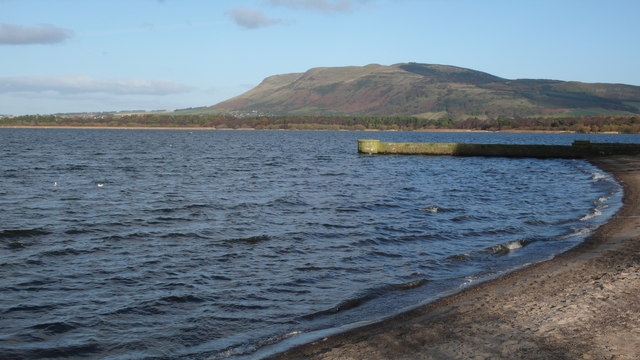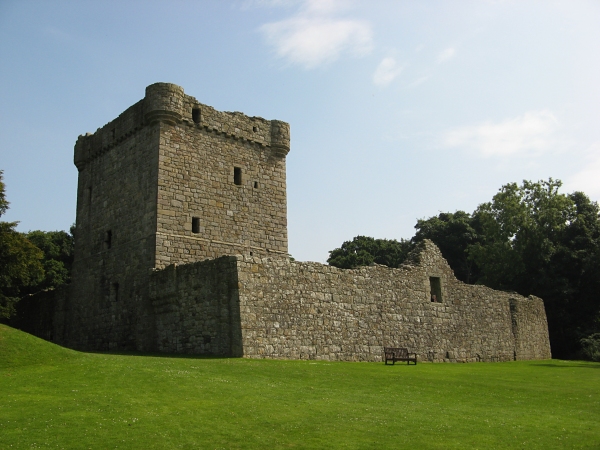
Skirting Perth, we head south toward Loch Leven in Kinross-shire, a shallow freshwater loch which was once much larger than its current eight miles in circumference, and much deeper.
An important freshwater wintering station for geese, swans and ducks, Loch Leven is designated a National Nature Reserve. Two islands are situated within the pear shaped loch: St. Serf's which holds the scant remains of a Culdee priory and another near the western edge of the loch where Loch Leven Castle stands.
The clouds are moving in and the water of the loch is turbulent and gray as we pull into the parking lot. I'm a bit disappointed not to see any sort of bird life here; it's the wrong time of year, I suppose. The grassy area leading to the dock is filled with visitors meandering about. The dock itself holds at least a dozen others.
Robin makes a quick dash down to the waters edge to determine how long it will be before the next ferry out to the castle appears while Dana and I light up (cough) in an attempt to stave off the midges. I've been lucky so far; apparently my blood isn't to their liking, but they don't need to actually bite to be annoying.
I walk down to the water to meet up with Robin in hopes that the stiff wind that's churning the loch will blow the clouds of midges away. They've made Dana so miserable that she's already heading back to the safe enclosure of the car. The next ferry will be along in twenty minutes, Robin's been informed by someone on the dock.
After snapping a few quick photos of the distant castle, which was visited twice by Robert I and played prison to Mary Queen of Scots, we head back to the car to discuss our options. As we walk, I wonder to myself if midges were as prevalent during medieval times. It's not something I'd ever considered before; besides primitive living conditions and the upheavals of warfare, the long-ago inhabitants of this area would be constantly swatting away swarms of biting insects.
We had never discussed visiting the castle; I had only wanted a glimpse of the loch itself, to make sure I'd portrayed it correctly in a historical fiction piece I've been working on for a couple of years. I am satisfied that I have and am perfectly willing to move on to Dunfermline.
With the crowds, weather and midges, Dana and Robin also seem amenable to moving on. Decision made. Into the car we pile with a few midges to keep us company. Dana manages to exact her revenge by squishing one on the inside of her window. I hadn't realized until that time that they are a very vivid shade of chartreuse.

Loch Leven Castle is a ruined castle on an island in Loch Leven, in the Perth and Kinross area of Scotland. Possibly built around 1300, the castle was the location of military action during the Wars of Scottish Independence (1296–1357). In the latter part of the 14th century, the castle was granted to William Douglas, 1st Earl of Douglas, and remained in Douglases' hands for the next 300 years.
Mary, Queen of Scots was imprisoned here in 1567–1568, and forced to abdicate as queen, before escaping with the help of her gaoler's family.
Loch Leven Castle had fallen into ruin by the 18th century, and was given in to state care in 1939. Today it can be reached by a 12-person ferry operated from Kinross during the summer months.
Read more about Loch Leven Castle at Wikipedia.